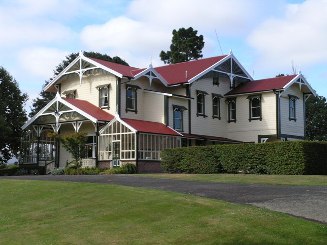|








| |
Our Stories
Olga Marie Monrad - A Danish
Pioneer, Mother and Wife
A
solitary marble cross stands in the Lutheran section of the Terrace End Cemetary.
Over the years, its white colour has darkened in places and the writing on the
marble has become more difficult to read. Here, most graves carry names of
Scandinavian descent. ‘Olga Marie Monrad’ the inscription on the cross says.
Click here
to read more .....
Taking Tea
with Aunt Maud
Tricia Keiller, who formerly lived at Atawhai, now
Ferguson Hall, provided this reminiscence of life in Caccia Birch house, from
conversations with her mother.
|
When my mother, Helena Keiller,
was a young mother in the 1930s she was occasionally invited to afternoon
tea with Aunt Maud [Caccia Birch] at Woodhey, as the house was then known.
At the time she was looking after and caring for Aunt Maud’s brother Ernest
James Keiller in her own home, Atawhai.
She would probably have worn,
in summer, a tailored linen or silk dress, necklace (maybe pearls) brooch,
silk stockings with a straight seam up the back and often two-tone white and
brown leather high heeled shoes. In the winter she would have worn a
comfortable coat and skirt and the same type of high-heeled shoes. A crepe
de chine long-sleeved blouse or very finely knitted jersey suitable for show
if she took off her coat would also be worn. Gloves were also important but
as it was a family invitation, she may not have worn a small tailored hat to
suit the occasion. She would have driven herself in her green and
black Wolseley car, as she had had her licence since the late 1920s. |
 |
Afternoon tea, she told me, was
taken in the front foyer, with a large fire in the winter. There were easy
chairs and a sofa around the fire with a large wild animal skin, I think a lion,
on the main part of the floor.
The tea things would be brought in at
a given time on a tray placed on a table beside Aunt Maud and a separate tray or
a wooden tiered cake stand would have contained the food. This would probably
consist of very thin brown bread and butter, a crisp biscuit or shortbread, and
a plain cake such as a seed cake.
 |
The
tea, Ceylon orange pekoe (bought in a 5lb wooden box) was served from a
sliver teapot, with a silver hot water jug to top up the teapot for a second
cup of tea. There may have been a silver jug but more often a china sugar
and milk jug were used. For a second cup of tea the remains of the first cup
were always tipped out into a larger matching china bowl.
Conversation would revolve around family and as my mother was starting her
family, that would also be part of the discussion plus the garden
(especially flowers) and sometimes domestic arrangements such as staff or
food preserving tips. The visit might also include a short walk around the
garden or conservatory. A specific time, say three o’clock,
would accompany the invitation and one would be expected to stay a maximum
of one and a half hours. One did not overstay one’s welcome.
|
The foyer in the Strang era, about 1910
|